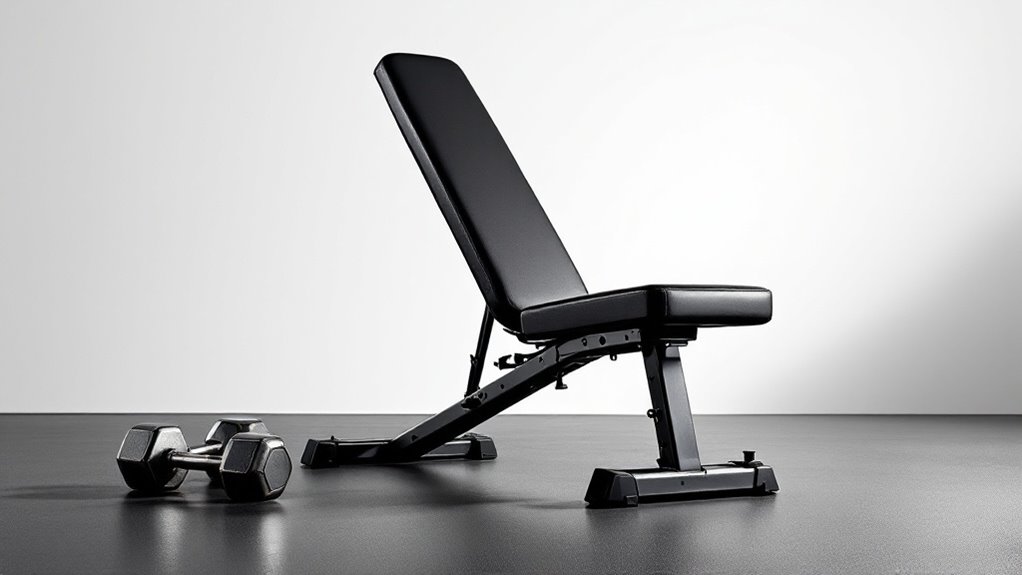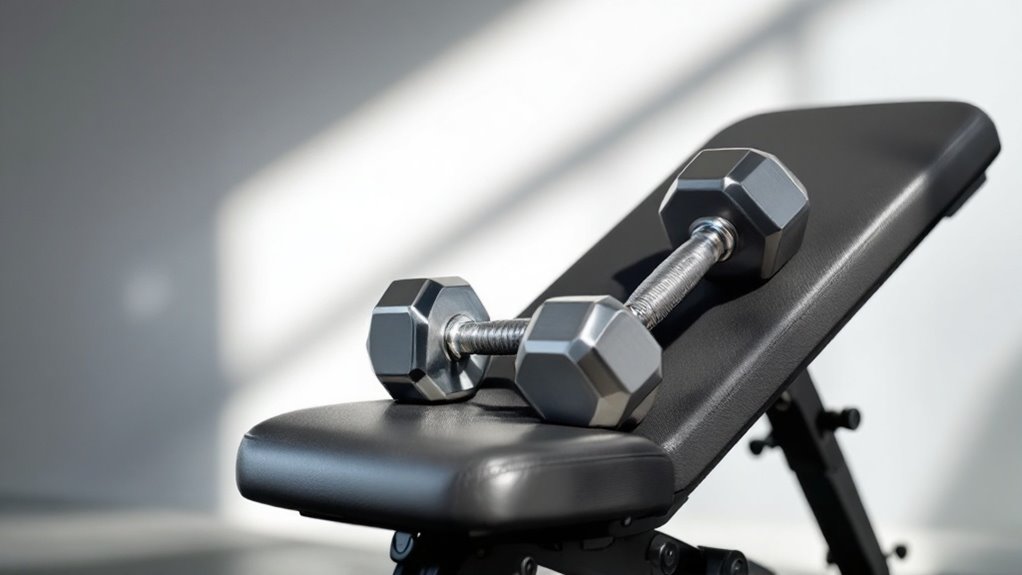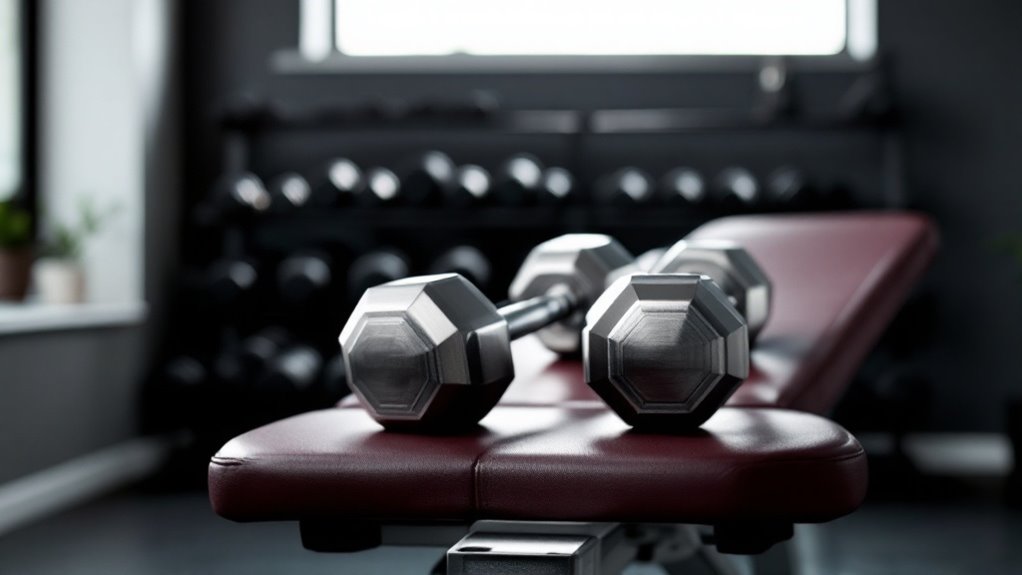Incline Dumbbell Chest Press

The incline dumbbell chest press targets upper chest development through precise angle selection and proper form. Performed on a bench set between 30-45 degrees, this compound movement involves the clavicular head of the pectoralis major while activating supporting muscles like anterior deltoids and triceps. For best results, athletes should maintain retracted shoulder blades, plant their feet firmly, and control the tempo. Training variables like sets, reps, and progressive overload release this exercise's full potential.
Key Takeaways
- Set the bench angle between 30-45 degrees and retract shoulder blades for optimal upper chest engagement and stability.
- Keep feet planted, maintain neutral spine, and control the weight through full range of motion for proper form.
- Perform 3-4 sets of 8-12 repetitions with controlled 2-3 second descents for maximum muscle stimulation.
- Lower angles (15-30 degrees) target chest more effectively, while steeper inclines above 45 degrees increase shoulder involvement.
- Use dumbbells for independent arm movement and improved range of motion compared to barbell variations.
The Science Behind Incline Dumbbell Press

Recent scientific research has clarified the precise mechanics behind the incline dumbbell press, particularly regarding ideal bench angles and muscle activation patterns.
Studies demonstrate that bench angles between 15-30 degrees optimize upper chest activation while minimizing excessive shoulder involvement. At steeper inclines above 45 degrees, anterior deltoid involvement increases considerably, reducing chest stimulation.
Keep bench angles between 15-30 degrees for maximum chest gains – steeper inclines shift focus to shoulders instead of pecs.
The independent movement pattern of dumbbells allows for natural elbow tracking and improved range of motion compared to barbell variants. Fitness experts recommend performing 3-4 sets of 8-12 repetitions for optimal results.
This bilateral loading prevents muscular imbalances while enabling targeted upper chest development. EMG data confirms that incline dumbbell presses rank among the most effective exercises for combined upper chest and tricep activation. The scientific experiment using the EMG machine Betty provided conclusive data showing optimal activation of the upper chest fibers at these specific angles.
Implementing progressive overload principles is essential for continuous strength gains and muscle development in this exercise.
Perfect Your Form and Technique

Mastering proper form and technique transforms the incline dumbbell press from a basic movement into a powerful upper chest developer. The foundation begins with setting the bench at a 30-degree angle, which enhances upper chest involvement while minimizing shoulder strain. This angle has been proven to deliver optimal muscle activation compared to steeper or flatter positions.
Proper execution demands strict attention to detail: feet planted firmly, shoulder blades retracted, and core activated. The exercise naturally challenges balance and coordination more than traditional barbell movements. Similar to the shoulder press, maintaining proper head alignment throughout the movement helps prevent neck strain.
Control the descent over 2-3 seconds, creating an arrow shape with the elbows while maintaining vertical dumbbell orientation. At the bottom, pause briefly to amplify the stretch before driving the weight up with power.
The key lies in maintaining form over ego, prioritizing controlled movements over heavy weights.
Training Variables for Maximum Results

Enhancing training variables stands as the cornerstone of achieving peak results with the incline dumbbell press. Success hinges on strategic angle selection, typically starting at 45 degrees for balanced chest involvement while preventing shoulder strain.
Lower angles between 30-45 degrees increase chest activation, while higher inclines require lighter loads. Maintaining proper shoulder blade retraction throughout the movement ensures optimal stability and muscle recruitment. A spotter should assist during near-failure sets to ensure safety and proper form.
For ideal progression, beginners should focus on moderate weights with 10-15 reps, while intermediates can push near-failure loads in the 6-12 rep range. Following the principle of progressive overload helps build consistent strength gains over time.
Advanced lifters should emphasize strict form with heavier weights. The key lies in controlling tempo with 2-3 second eccentric phases and implementing periodic angle adjustments to prevent plateaus.
Advanced Tips and Programming Strategies

To raise the incline dumbbell press from basic movement to advanced strength builder, lifters must implement sophisticated programming strategies and technique refinements.
The following tactics can markedly improve training outcomes when properly executed:
- Rotate between 30-45° angles monthly while incorporating pause reps and 1.5-rep variations to prevent adaptation plateaus. Emphasizing the clavicular head through proper bench angles ensures balanced upper chest development. The exercise delivers greater muscle activation compared to traditional barbell pressing movements. Following a progressive overload approach ensures continuous strength gains over time.
- Utilize cluster sets (5×5 with 20s rest) paired with flye variations for thorough development.
- Implement controlled 3-4 second eccentric tempos with thumb-leading presses for maximum chest involvement.
- Progress from strict form mastery to explosive lockouts while maintaining proper elbow positioning 6-12 inches from torso.
Frequently Asked Questions
Can I Do Incline Dumbbell Press if I Have a Shoulder Impingement?
Shoulder impingement requires careful exercise modification.
While traditional incline pressing can aggravate symptoms, modified versions may be possible with proper form adjustments.
Key modifications include using lighter weights, maintaining controlled movements, avoiding full lockout, and keeping elbows below shoulder height.
Alternative exercises like decline push-ups or cable work might be safer options.
Consulting a physical therapist for personalized guidance is recommended.
How Long Should I Rest Between Sets of Incline Dumbbell Press?
Between moments of muscular involvement, rest intervals should correspond with training objectives.
For strength gains (3-5 reps), rest 3-5 minutes. For muscle growth (8-12 reps), take 2-3 minutes.
Beginners using lighter weights can rest 30-90 seconds. Advanced lifters moving heavier dumbbells should rest 3-4 minutes.
Rest periods can be adjusted based on fatigue levels and form quality.
Should I Wear Wrist Wraps During Incline Dumbbell Press?
Wrist wraps are recommended when lifting heavier weights (80%+ 1RM) or during high-volume sets. They provide joint stability, prevent hyperextension, and reduce strain on ligaments and tendons.
However, they shouldn't be relied upon for every workout. Regular grip and forearm strengthening exercises should be prioritized for long-term wrist stability.
Use wraps strategically during challenging sets while developing natural strength.
Is It Normal for One Arm to Be Weaker During Incline Press?
Muscle imbalances are common, with most people naturally having a stronger dominant side.
This asymmetry becomes more noticeable during unilateral exercises that force each arm to work independently.
While concerning at first, these differences are typically within normal ranges.
The key is recognizing and addressing the imbalance through targeted training, proper form, and progressive overload focused on strengthening the weaker side.
Can Incline Dumbbell Press Help Improve My Bench Press Strength?
Incline dumbbell press can considerably improve bench press strength through several mechanisms.
It develops upper chest muscles, boosts stabilizer strength, and addresses muscle imbalances between arms. The exercise reinforces proper form through independent arm movement and builds shoulder stability.
Regular incorporation of incline dumbbell work can increase overall pressing power while reducing injury risk through balanced muscular development.
Final Thoughts
Like a sculptor chiseling away to reveal hidden potential, mastering the incline dumbbell press transforms chest development. This fundamental exercise, when executed with proper form and strategic programming, delivers exceptional upper chest gains while enhancing overall pressing strength. Whether you're a novice or seasoned lifter, incorporating this movement into your routine with the right approach will raise your chest training to new heights.


